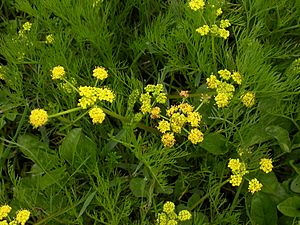Bradshaw's desert parsley facts for kids
Quick facts for kids Bradshaw's desert parsley |
|
|---|---|
 |
|
| Conservation status | |
| Scientific classification | |
| Kingdom: | |
| (unranked): | |
| (unranked): | |
| (unranked): | |
| Order: | |
| Family: | |
| Genus: | |
| Species: |
L. bradshawii
|
| Binomial name | |
| Lomatium bradshawii |
|
| Synonyms | |
|
|
Lomatium bradshawii, also known as Bradshaw's desert parsley, is a special plant. It is a type of herb that grows back every year. This plant is very rare and is considered endangered. This means it is at risk of disappearing forever. It naturally grows in parts of Oregon and Washington in the United States.
Contents
About Bradshaw's Desert Parsley
For a long time, people thought Bradshaw's desert parsley had vanished completely. But in 1979, a student from the University of Oregon found it again! This was a very exciting discovery.
Why It's Rare
This plant used to be common in an area called the Willamette Valley. However, as farms grew and people started preventing natural fires, things changed. Shrubs and weeds began to take over the areas where Bradshaw's desert parsley lived. This made it harder for the plant to survive.
Where It Lives
Most of the known groups of Lomatium bradshawii are found near Eugene, Oregon. In the Willamette Valley, you can find this plant in Oregon's Lane, Benton, Linn, and Marion counties. In Washington, it grows in the Puget Sound area.
The largest group of these plants is in Camas Meadows, Washington. It has a very large population of plants. The Berry Botanic Garden also helps protect this plant. They keep a seedbank, which is like a special vault for seeds. This helps make sure the plant can be grown again if needed.
What It Looks Like and Where It Grows
Lomatium bradshawii likes to grow in low areas. You can often find it along rivers or in prairies that flood regularly. When it blooms, usually from April to May, it has yellow inflorescences. An inflorescence is a cluster of small flowers on a single stem.


